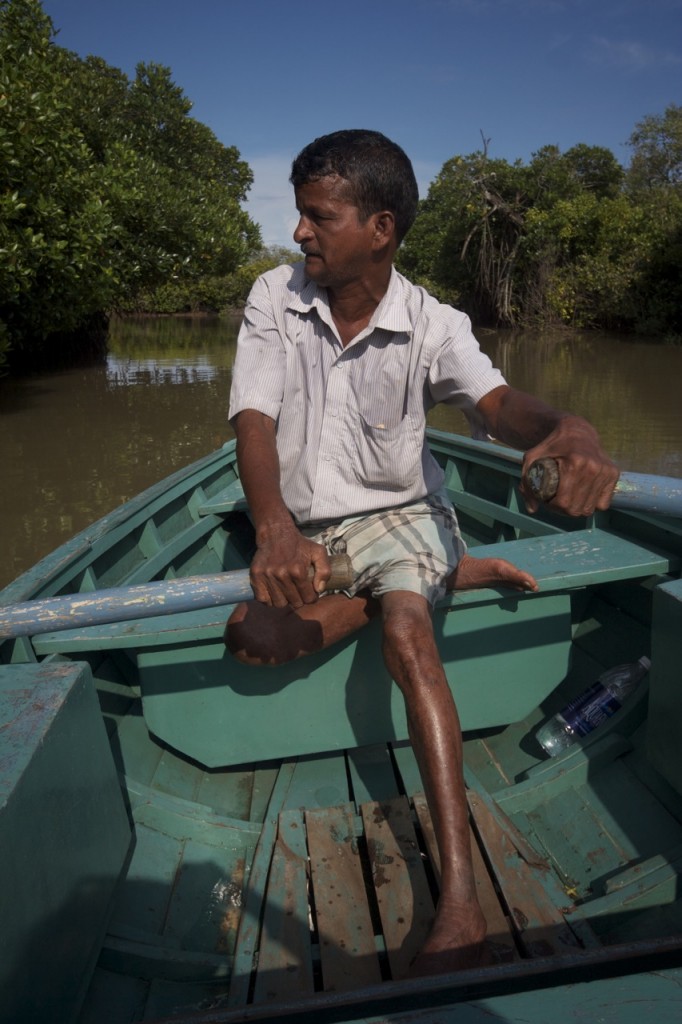“This is the world’s #2 mangrove forest,” my rower Gopalam says as we navigate the waters of the Pichavaram mangrove forest in Tamil Nadu, India.
“These trees prevent tsunami. Otherwise, many people die.”
Gopalam is a small man with thin legs, one kept pulled up under him as he rows. I’m feeling slightly guilty as he leans forward with each stroke, propelling me further forward. You can taste the salt in the breeze blowing across the water; it’s cool on my skin as we head into the forest, a thick maze of twisting natural passages. It’s completely quiet, except for the thwack of Gopalam’s occasional spit.
The forest edges up to a small village also called Pichavaram, about half an hour from the larger city of Chidambaram and its famous temple of the dancing Shiva. After a brief mention in my guidebook, I’d wanted to stay in Pichavaram for the night, but was disappointed to learn the guesthouse had closed last year.
My only remaining option is a privately owned eco-resort that charges six times the amount I’m used to paying for a room.
I say no thanks to the resort, but stick around long enough in Pichavaram to discover what mysteries this mangrove forest holds.
Everywhere I look, the lake is enclosed by a fringe of trees. There’s only water and mangrove trees–no real shore to speak of. The only small bit there is has been lined with wooden fishing boats, their bows turned up and paint faded.
The mangroves’ roots seem a tangled mess of firewood kindling–it’s hard to believe they’re part of a living, breathing organism. As we pass an island, a single white crane lifts from a branch and swoops along the surface of the water.
When I ask if it’s lake or a river, Gopalam pauses, thinking for a moment.
“Lagoon. The river connects to the bay,” he says, referring to the nearby Bay of Bengal.
The lagoon itself is shallow, barely four or five feet deep. Another man ferries his family across the water in a canoe, pushing them forward with the jab of a long pole.
As we approach the forest, the trees seem to form an impenetrable whole, an endless barrier between the water and what lies beyond its twisted roots. The closer we get, though, the more the small passageways open up. I can only wonder if they’ll let us out.
“So,” Gopalam says. He’s pulled over to a huge stand of twisted roots growing in the water and I wonder if he’s about to tell me more about the unique eco-culture of the forest, or perhaps how the roots receive their nutrients, or maybe a profound thought on life in the forest after the 2004 tsunami. I’ve got my notebook out; I’m ready to write.
“So,” he says again, “I ask you a question. Who founded America. Columbus or Vespucci?”
I look up from my notebook to see if he’s serious. He is.
“Who was it? Columbus or Amerigo Vespucci? You know, America.”
Yes, Gopalam, I know. After debating this oh-so-relevant issue for a few minutes, I ask if I can have a go behind the oars. He agrees and we switch seats. I brush away a few stray hairs and grip my hands tight around the oars. A few strokes in and already I can tell–like so much in life–this is harder than it looks.
Once we’re out onto the open surface of the lagoon again, I give the reins back to Gopalam.
Even if I wasn’t able to stay the night, Pichavaram was definitely worth the ride.
How to get to Pichavaram:
If you’re heading to places like Chennai or Pondicherry anyway, a daytrip to Chidambaram is definitely worth considering. The bus from Pondicherry is 24 rupees each way and takes 2-3 hours.
At the Chidambaram bus stand, feel free to use my method of asking anyone and everyone, “Bus to Pichavaram? Pichavaram, anyone?” Hopefully, someone will point you in the right direction. This bus costs 7 rupees and takes half an hour to reach the resort.
Saradharam Eco-Resort
- www.pichavaram.co.in
- (+91) 04144 249299
- Rooms start at 1,800 rupees a night and there’s also a restaurant on-site.
Rowboat rentals
- One hour (rower included) is 110 rupees, two hours is doubled to 220.
- There’s also a motorboat option, but this really only appeals to groups as it’s quite expensive (800 rupees and up). Plus, why take a motorboat when you can row your own way through the mangroves?










This looks SO cool – I love the image of the trees crowding in on all sides. I haven’t been to a mangrove forest quite like this, though I did go on a firefly watching tour in the Philippines that took us down a mangrove-lined river. It was absolutely, absolutely amazing – but I do want to see something like this in the daytime!!
Thanks, Naomi! It was definitely a cool experience–although your firefly tour sounds amazing as well. Nellie from WildJunket is in the Philippines right now and it looks absolutely incredible. I’d love to visit one day!
Love the photos, particulalrly the one where shadows play and frame the areas in the photo and also the photo of the mangrove leaves (one before the last) 🙂
thats good you had a great time exploring and had better luck with the rowing this time!!
Haha yes, but that’s probably because I wasn’t involved with most of the rowing. I’ll get there one day, I hope! Glad you enjoyed the piece.